Summary: What is the best behavior and action to prepare for trading and investing? Get insights into what is needed to change your outlook and results or decide not to trade! What we share can be life-changing, and it takes a moment of reading and comprehending.
In many disciplines in life, one can get through with mediocre results:
- You achieve a high school diploma
- Graduate with a bachelor’s degree or even master
- Get a job that pays your bills
In trading or investing, mediocre performance or attitude guarantees long-term losses.

The issue with trading: even a great attitude and discipline can substantially hinder achieving your goals.
We best explain by a graphic that relates the abilities of:
- Waiting for the perfect setup, instead of acting at every possibility
- Having the discipline of being prepared for the trading day and acting when it matters
Knowledge is another dimension, but we leave that aside at this point and spin a two-dimensional matrix considering the two behavior variables and four quadrants:
Behaviour Matrix of Traders/Investors
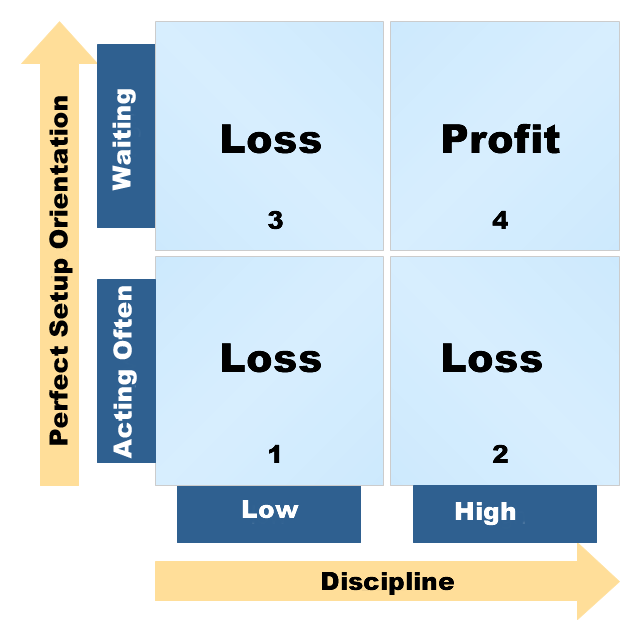
Quadrant-1: Traders with minimal discipline and preparation operate at frequent trade setups and have no other chance than producing constant losses. We often meet people who are not prepared to make fast trading decisions but dedicate themselves to deciding from one or five-minute charts.
Quadrant-2: Highly disciplined and prepared persons with frequent transactions still produce losses because they accept trade setups that are not highly probable, and as a result, their losses outweigh the gains. In this quadrant, we find highly skilled people that are successful in other disciplines but not trading or investing.
Quadrant-3: By applying little discipline, traders in this quadrant miss opportunities and act on lower likely chances when their time allows instead of when the market allows. The result is higher losses than gains.
Quadrant-4: This is what it takes: the solid discipline of preparation and the patience to wait for the perfect setups to act, considering system probability and the overall market development. We will fill this with life now.
The probability of your system and the control of your behavior both influence your trading results.
Here are some of the determining factors we will further investigate:
System and Behavior Components
| System | Behavior |
| High probability≥ 65% Specified entries, exits, stops Trading at Price Turning Points Risk-Limiting Strategies | Structured Prepared Repetitive Disciplined |
Most traders forecast price moves around the 50% to 55% level, using an old-fashioned decision-making basis that does not propel for today’s markets. So let us calculate the difference between a model with a 55% probability and one of 65% and estimate the expected likelihood of winning six or more out of 10 trades. Here are the results:
- A 65% system gives you a 75% chance to predict and win six or more out of ten trades.
- A 55% only gives you a 50.4% chance for six or more winners (random predictability).
You know now why we propagate high over low probability.
Trading success could have a simple equation: when you show higher wins than losses and win more often than you lose, everything is set and done to make money long-term.
However, easier said than done.
The above equation would sponsor the behavior of accepting minor losses and letting your winners rise.
Unfortunately, beginning traders fall into this trap: set tight stops, try to let their winners run, and still lose.
Why does that happen?
To capture an entire or part of an evolving price movement, you need to leave enough wiggle room to avoid getting stopped in the natural statistical price volatility of the asset you trade.
Let me give you an example with the following assumptions:
- Your system identifies a price move potential for $10
- The likelihood of the setup is 65% (high probability)
- The natural price behavior fluctuates with a $10 tolerance.
If you only allow for a $1 risk by setting a tight stop, you will always get stopped and never bring the trade to target. After being stopped ten times, you most likely will not push the trigger on the next opportunity and seek a new system.
Opposite to the base assumption, a tight stop setting is a tangible way to lose money constantly.
This triggers the question:
How much wiggle-room to leave when trading?
We built a quantitative model, and here are the research results:
Study Results of Risk/Reward Relations

If you leave a 1.2-times wiggle room, you have an 80% chance of getting your trade to the specified target.
Ok, we now know where to set the stop; however, what is mostly missing is a proven model to forecast a price movement in distance and time, so you can relate the stop setting to it. Most forecasting models fail because the price movements in the financial markets are generally not normally distributed; they happen erratic and are best described by a leader and follower model, where the crowd follows the leaders!
We built a model based on an erratic price distribution and Mandelbrot math to replicate the actual happening in the financial markets.
NeverLossTrading Price Move Model
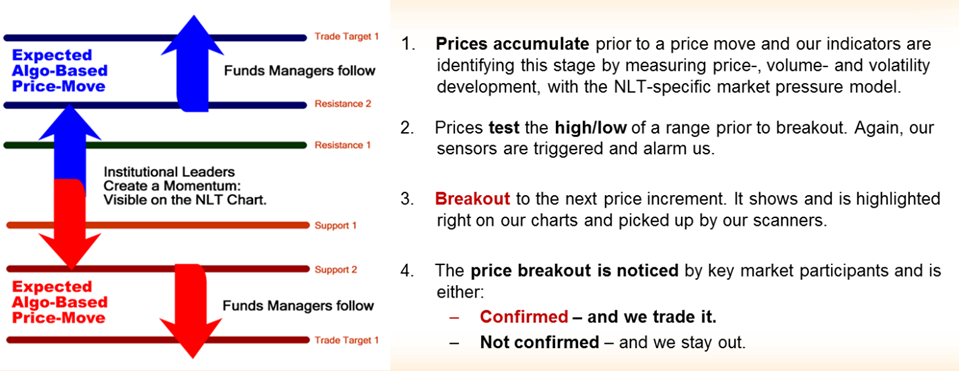
Theory: Key asset holders will have a solid need to re-balance their inventories. Thus, at a particular price expansion, they will either float- or shorten supply, which will result in an opposite directional price move that will then take away from our profits. Knowing this, we pre-calculate how far the expected price move will reach, and there we take profit, assuming it will retrace or reverse after.
Hence, we let the market and institutions appraise the asset price journey and latch on, entering and exiting positions faster than institutions can.
Our tool to calculate the expected price move is the SPU = Speed Unit, and it indicates how far a price move shall reach until it comes to an end.
With our systems, you can operate with conditional buy-stop and sell-stop OCO orders (one-cancels-the-other). Without the need to be in front of your computer for the orders to execute. You enter by price thresholds, ensuring that other market participants have the same directional assumption as you do and exit at the SPU target or adjust the trade at the stop.
NeverLossTrading SPU Model
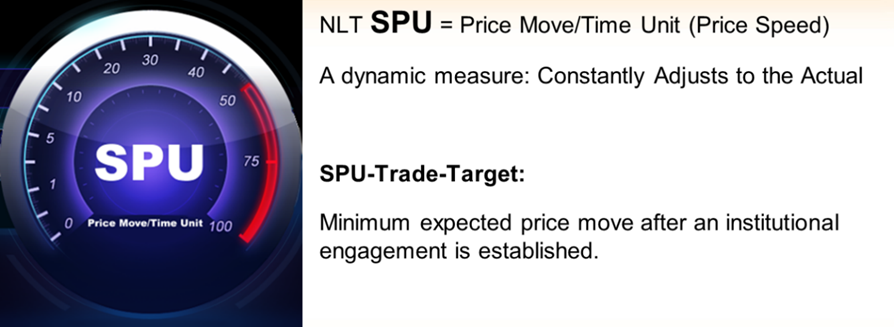
By a change in the frequency and amplitude of the price movement over time, we specify indications to act on high probability price turning points, applying mechanical rules rather than leaving room for interpretation.
Takeaways
- Operate with a system that gives you a 65% or higher likelihood of forecasting price movements at critical price turning points.
- Let your system extrapolate the price movement for where to take profit.
- Define your stop by a maximum of 1.2-times the reward you are striving for.
After setting system requirements, what behavior and preparation are critical to strive for a constant income?
Important Behavior Components:
- In trading, your system is supposed to tell when to buy or sell. However, there is nothing to do at times, and not-successful traders feel they did nothing if they did not trade, while successful traders accept the fact.
- Successful traders consider more factors in their trading decisions. Opposite to this, novice traders tend to act overconfident and impulsively. They take more significant risks without looking at the bigger picture and tend to urge revenge trades after they booked a losing trade: now it has to work, period!
- Successful traders create greater financial returns by acting less frequently and holding positions to the system-specified target. On the other hand, novice traders often tend to cut their trades to targets short (anticipating it could turn in the opposite direction).
- Traders that make money are more likely to deliberate before placing a trade and don’t enter until their belief in the trade is high, often waiting for multiple indicators to be in sync and then act. Generally, they don’t take sub-optimal setups as often as novice traders, producing a higher winning percentage.
- Most retail traders are more prone to refusing to admit when they are wrong and hold on to losing trades longer than they should, hoping that they will turn around. On the other hand, pro-traders tend to admit mistakes more quickly and are more willing, and they tend to adhere to a strategy more strictly and are better at cutting losses.
- Many retail traders tend to seek entertainment in trading, where they like to act on very short-term happenings, not considering that by the pure setup of the trade, considering slippage and commissions, they trade for action and will never make a return. However, successful traders are faster convinced and apply a meaningful approach to act at situations and setups where the odds are in their favor.
- Conserving capital is essential in trading, and the available data suggests that trading pros tend to be more risk-averse than the average private trader. As a result, they trade less often and execute less risky strategies.
- Pro-traders may also be more likely to focus on a smaller asset base, allowing for more knowledge gathering and better management of trades with fewer areas to watch.
- Some researchers consider most retail traders to act more competitive, contrary to pro-traders that avoid getting caught up in the adrenaline rush of the moment and focus instead on their eventual spending goals.
- Successful traders have already experienced that trading is not easy and therefore are more determined to succeed, including dedicating time to practicing strategies and finding a mentor whose advice they feel comfortable heeding.
Let us put our findings into a graphic:
Crucial Trading Success Factors
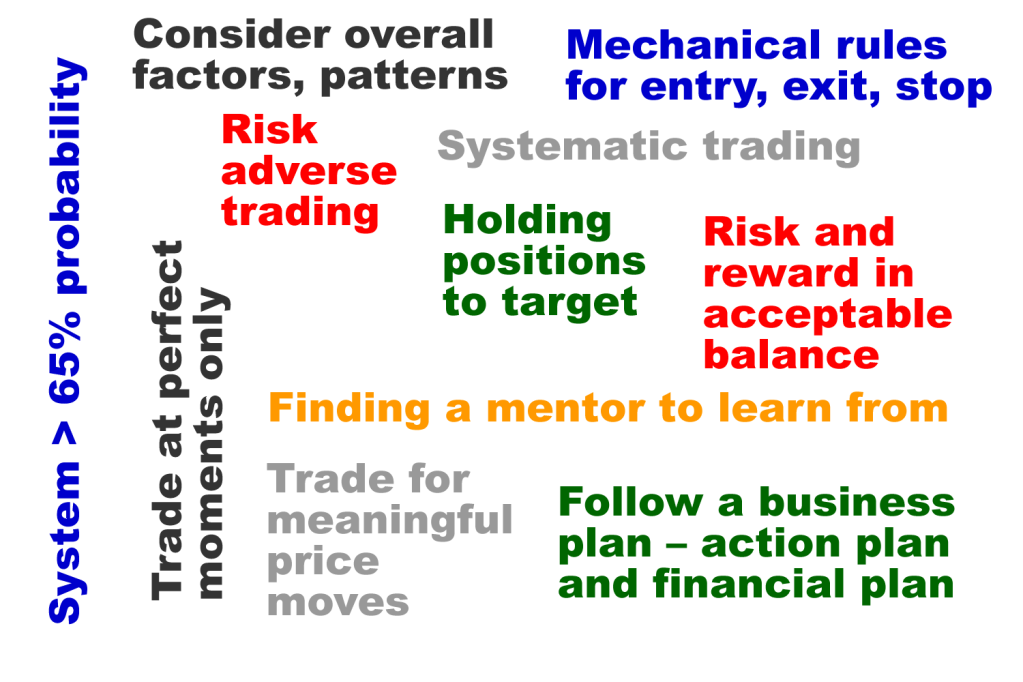
In Summary:
- Trade with a high probability system gives you mechanical rules for trade entry, exit, stop, or adjustment.
- Have a business plan for trading that you stick to, containing an action plan (when and how to trade, when not) and a financial plan (assets, timeframes, return opportunities and the financial goal).
- Analyze the situation well and take only fewer, high quality/high probability trades.
- Do not add to losing positions and hold your winners to target.
Our mentorships help you have all this in place, but you still need to work with your inner nature, knowledge base, preparation, and acting.
Our coaching programs teach how to use our system indications in combination with strategies and the needed behavior to strive for trading success.
In the NLT Timeless concept, we help you to specify all critical trading elements at the spot, with entry conditions, exit, and stop in place, at acceptable risk/reward constellations. It takes five decision-making components down to one: when to enter.
Let us start with a timeless, time-based chart with a swing trading perspective.
On the NLT Timeless example, we pick the E-Mini S&P 500 Futures Contact: Each highlighted price move represents a value change of the underlying contract of about $7,500.
/ES Swing Trading Chart March – August 2022
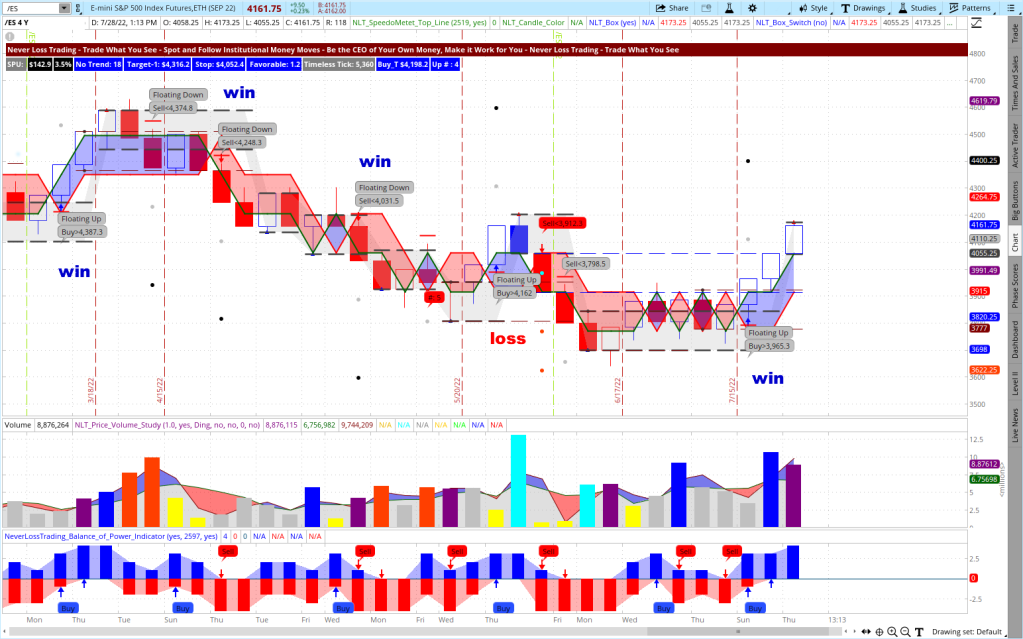
We are considering mechanical rules (accepting each signal), and the above chart showed five critical price turning points in the last four months. Four were winners, one a losing trade.
Explaining all details you see on the chart would be an undertaking outside the borders of this publication, and we are happy to hold an online meeting with you to demonstrate what the system can do for you:
contact@NeverLossTrading.com, Subj.: Demo
Next, we pick the stock of Apple Inc. to demonstrate how the NLT Top-Line indicators show crucial price turning points on daily charts:
AAPL Daily NLT Top-Line Chart June to August 2022
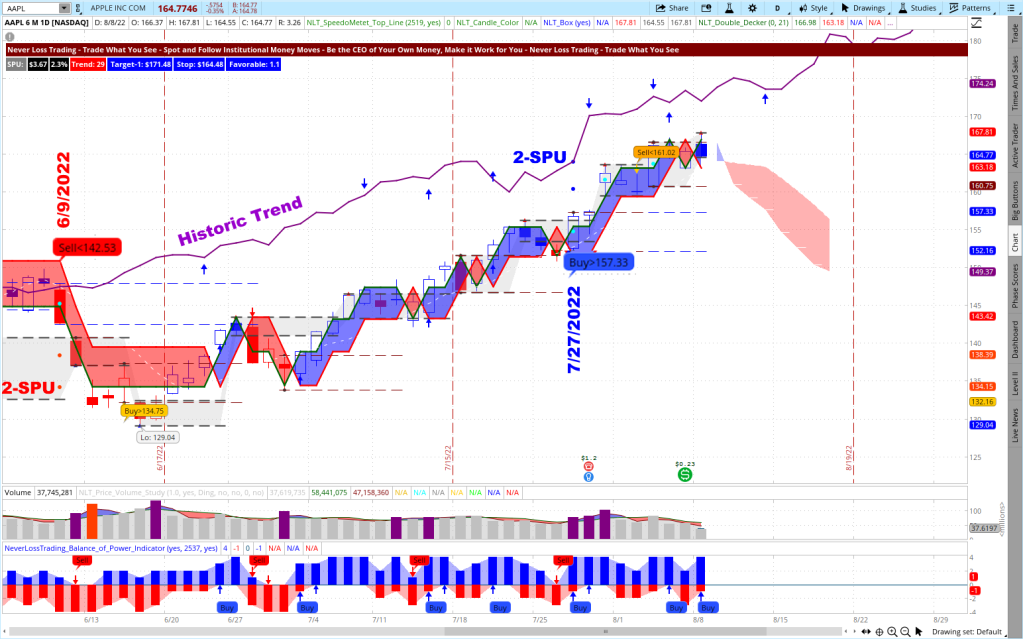
On the chart, we highlighted two solid trade situations: June 9, with a short signal, and July 27, 2022, with a long signal. The signal direction was confirmed in both cases, and the price development followed the historical trend. We printed a sign at the 2-SPU price level on the chart: this is where our system proposed to take profit.
In the day trading chart example, you see a signal combination that follows the NLT Timeless concept:
- A system-defined price base forms each candle
- Time is no critical element; only price change is tracked and defines entry and exit in a transaction.
We put a combination of NLT Top-Line, Trend Catching, and Timeless Indicators on the chart. Our focus is to look and act on two happenings, whatever comes first:
- A sign that shows a floating print means the price is trading towards open space with less resistance
- Signals showing a breakout sign signify that the price leaves a prior price containment
E-Mini S&P 500 Day Trading Chart August 5, 8, 2022
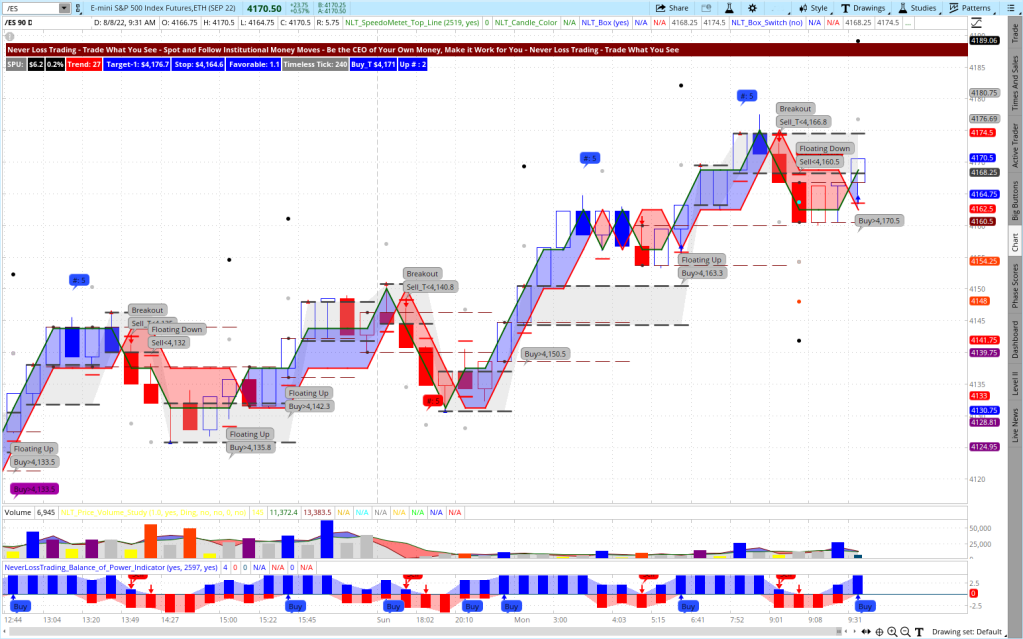
You see multiple signals and signal combinations, where we take a mechanical approach. Check the chart and find six price turning points to act on:
- The dot on the chart is the exit
- The red crossbar signifies the stop
- When you are in a trade to target, disregard the same directional or opposite-facing signals
- The system only prints signs where risk and reward are in balance with the system probability of having a positive expectation value
With the NLT Timeless concept, we help you put five trading decisions in one spot:
- Acting on buy-signals above the set price threshold through buy-stop orders
- Acting on sell signals below the set price threshold through sell-stop orders
NLT Timeless Trading is only one way of putting our systems into action. We work one-on-one with our clients and develop tailored strategies that fit your circumstances, wants and needs. To experience how our systems work in real-time, schedule an online meeting with us:
contact@NeverLossTrading.com, Subj.: Demonstration.
After sharing the importance of a solid system, let us bridge over to behavior:
- Do not come to trading with a work attitude. Making money in trading requires an intelligent attitude: Cash in your profits and leave the risk to somebody else!
- Prevent overtrading
- Stick to a business plan for trading success: action plan (when to trade and when not), financial plan (how often to trade, what to expect).
We have over ten years in the trading education business, teaching one-on-one at your best available days and times.
Trading our own account day-by-day and helping clients lets us provide long-term experiences and support. Customer service and tailored mentorships are our virtue. Following this principle, we provide:
- Server-installed Software
- Real-Time Data
- System-Defined Entries, Exits, and Stops
- Position-Sizing
- Time-in-a-Trade
- Trading-Strategies
- Risk-Handling
- Business Plan (financial- and action plan)
- Own scanners to find investment opportunities
- Watch list indicators for finding changes in supply and demand on multiple time frames
Basing your trading and investing decisions on defined rules is learnable, and we are here to support you!
Schedule your consulting hour! Working one-on-one spots are extremely limited: Do not miss out!
+1 866 455 4520 or contact@NeverLossTrading.com
Let us share an overview of learning elements to take away from our training and coaching sessions, which vary based on the system you choose, from four to twenty hours of teaching.
Summary of learning elements:
- Acting with a system probability > 65%
- Mechanical rules for entry, exit, stop
- Trade at perfect moments only
- Consider overall factors, patterns
- Risk and reward in an acceptable balance
- Risk-averse trading
- Holding positions to target
- Do not add to losers
- Stick with a trading strategy. Follow a business plan – action plan and financial plan
- Trade for meaningful price moves
- Systematic trading
- Having a mentor to learn from
To succeed in trading, you best work with an experienced coach and learn much about trading. Our #1 competitive advantage is the support and customer service we offer. We work one-on-one with you to specify what we teach to your specific wants and needs; hence, if your knowledge base is not expanding rapidly, you are doing something wrong.
Ongoing education and mentoring are crucial to longevity in this business.
Veteran traders have been through more ups and downs than you can imagine. So whatever you’re going through, experienced pros have probably experienced it already.
If you are ready to make a difference to your trading:
contact@NeverLossTrading.com Subj: Demo.
We are ready to share our experiences and help you build your trading business. Trading is not a typical career, and you best learn from those who are long-term in this business to cope with the rollercoaster of the financial markets. We are here to help and provide feedback on what you might be doing right or wrong.
Strive for improved trading results, and we will find out which of our systems suits you best.
We are happy to hear back from you,
Thomas Barmann (inventor and founder of NeverLossTrading)
Disclaimer, Terms and Conditions, Privacy | Customer Support


No comments:
Post a Comment